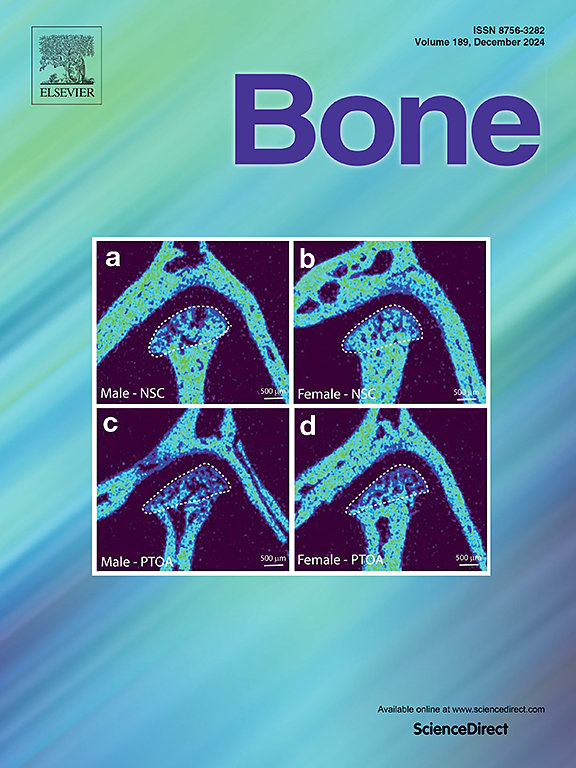Automated micro-CT morphometry of femoral biopsies from hip arthroplasties: adaptive local thresholding, volume of interest wrapping and removal of debris
IF 3.5
2区 医学
Q2 ENDOCRINOLOGY & METABOLISM
引用次数: 0
Abstract
Bone biopsies are an important biological tool for investigating bone microarchitecture, which can be non-destructively imaged in 3D via micro-computed tomography (micro-CT). Image thresholding and delineation of a region of interest (ROI) are prerequisites for quantifying bone parameters. Validated automatic protocols enable quantification of biopsies that contain trabecular and cortical bone. However, irregularly shaped trabecular bone biopsies with peripheral and internal debris have required manual ROI delineation, which is time-intensive and subject to inter and intra-observer variance. We hypothesise that an automated workflow will be a suitable alternative to overcome these issues and objectively determine bone microarchitecture in surgical biopsies, at higher throughput suitable for clinical studies. Hence, the aim of this study was to develop an objective, reproducible and automated workflow to analyse microarchitecture of trabecular bone biopsies. To accomplish this aim, we tested six different methods of ROI delineation: a whole biopsy ROI, and both manual (slow) and automatically delineated (fast) reduced ROIs to remove peripheral debris, each with (adaptive thresholding and a set of morphological operations to remove debris) and without (global thresholding) processing in a subset (n = 8) of intertrochanteric femoral biopsies obtained from patients undergoing hip arthroplasty. Number of objects, bone volume to tissue volume (BV/TV), trabecular separation (Tb.Sp), structure model index (SMI) and Euler number and trabecular pattern factor (Tb.Pf) were compared between the six workflows using Friedman's test and post-hoc pairwise comparisons with Bonferroni correction was performed. The two most reproducible techniques were tested for validation in a larger cohort of arthroplasty patients (n = 60) and results were compared with appropriate t-test. Subset analysis indicated that the manual and automated ROI with processing increased the ability to resolve real differences between these groups in parameters BV/TV, Tb.Sp and Euler number compared to with no processing and whole biopsy ROI approach. A validation cohort consisted of thirty osteoarthritis patients with a mean age 68.25 ± 8.64 and thirty neck of femur fracture with a mean age 82.4 ± 8.9. The manual technique failed to detect differences in BV/TV, SMI and Tb.Pf between the two patient groups (p > 0.05, for all) while the automated workflow demonstrated significant differences in these parameters between the OA and the NOF patients (p < 0.05). This is probably due to irregularity in the reference VOI volume introduced by manual ROI delineation reducing morphometric precision, compared to the automated method. In conclusion, our automated workflow performed better than customary practice; it represents a user-independent, high throughput technique to measure bone microarchitecture accurately in surgical biopsies.
髋关节置换术后股骨活检的自动微ct形态测量:适应性局部阈值,兴趣包裹体积和去除碎片
骨活检是研究骨微结构的重要生物工具,可以通过微计算机断层扫描(micro-CT)进行非破坏性的三维成像。图像阈值化和感兴趣区域(ROI)的描绘是量化骨参数的先决条件。经过验证的自动协议能够量化包含小梁骨和皮质骨的活检。然而,不规则形状的骨小梁活检伴有周围和内部碎片,需要人工ROI描绘,这是费时的,并且受观察者之间和内部差异的影响。我们假设自动化工作流程将是一个合适的替代方案,以克服这些问题,客观地确定外科活检中的骨微结构,以更高的通量适合临床研究。因此,本研究的目的是开发一种客观、可重复和自动化的工作流程来分析小梁骨活检的微结构。为了实现这一目标,我们测试了六种不同的ROI描绘方法:全活检ROI,手动(慢)和自动描绘(快速)减少ROI以去除周围碎片,每种方法都使用(自适应阈值和一组形态学操作来去除碎片)和不使用(全局阈值)处理(n = 8)从髋关节置换术患者获得的股骨粗隆间活检。使用Friedman’s检验比较六个工作流程之间的物体数量、骨体积与组织体积(BV/TV)、小梁分离(Tb.Sp)、结构模型指数(SMI)以及欧拉数和小梁模式因子(Tb.Pf),并进行事后两两比较,并进行Bonferroni校正。在更大的关节置换术患者队列(n = 60)中对这两种最具可重复性的技术进行验证,并将结果与适当的t检验进行比较。子集分析表明,手动和自动ROI处理增加了解决这些组之间参数BV/TV, Tb的实际差异的能力。Sp和欧拉数与无处理和全活检ROI方法相比。验证队列包括30例骨关节炎患者,平均年龄68.25±8.64岁,30例股骨颈骨折患者,平均年龄82.4±8.9岁。手工技术无法检测到BV/TV、SMI和Tb的差异。两组患者之间的Pf (p >;0.05),而自动化工作流程显示OA患者和非OA患者在这些参数上存在显著差异(p <;0.05)。这可能是由于与自动化方法相比,人工ROI圈定引入的参考VOI体积中的不规则性降低了形态测量精度。总而言之,我们的自动化工作流程表现得比习惯实践更好;它代表了一种独立于用户的高通量技术,可以在外科活检中准确测量骨微结构。
本文章由计算机程序翻译,如有差异,请以英文原文为准。
求助全文
约1分钟内获得全文
求助全文
来源期刊

Bone
医学-内分泌学与代谢
CiteScore
8.90
自引率
4.90%
发文量
264
审稿时长
30 days
期刊介绍:
BONE is an interdisciplinary forum for the rapid publication of original articles and reviews on basic, translational, and clinical aspects of bone and mineral metabolism. The Journal also encourages submissions related to interactions of bone with other organ systems, including cartilage, endocrine, muscle, fat, neural, vascular, gastrointestinal, hematopoietic, and immune systems. Particular attention is placed on the application of experimental studies to clinical practice.
 求助内容:
求助内容: 应助结果提醒方式:
应助结果提醒方式:


